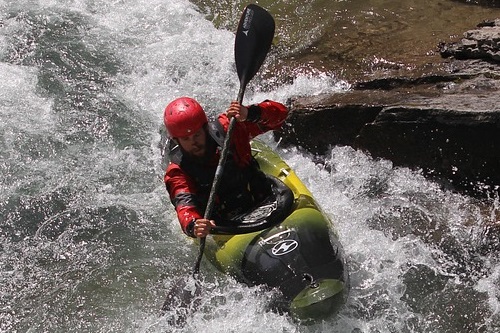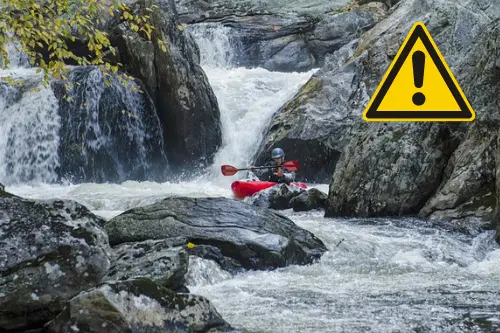If you’re interested in whitewater kayaking, you have the right to know if it’s dangerous. But without any experience and knowledge about this paddling sport, you probably see dangers everywhere when you look at rapids. Well, it might not be as risky as you think.
Whitewater kayaking can be dangerous, but with the right skills, equipment, people, and conditions, it can also be relatively safe. Dangerous water features, weather, inexperience, and bad judgment, may lead to injuries or even death. However, the inherent risks of whitewater kayaking are quite easy to mitigate.

Now, you might wonder how. By understanding the potential dangers, you will be able to avoid them as much as possible. But as with any other sport, there are always risks involved. So let’s figure out how dangerous kayaking is!
What Makes Whitewater Kayaking Dangerous?
The unpredictable water and obstacles in it make kayaking in rapids quite risky. You never really know how your kayak will react in whitewater. Then, if you add some rocks, trees, and other debris into the mix, you get a dangerous environment.
That’s why whitewater kayakers risk flipping over in the water, hitting something, getting injured, and maybe even drowning. But with good paddling skills and experience, you should be able to avoid dangerous sections, recover from a capsize, and navigate rapids reasonably safely.
The real danger in whitewater kayaking is ignorance, inexperience, and misjudgment. If you don’t understand the risks, you won’t be able to mitigate them. Then, you will need practice and time to improve your paddling skills and knowledge about rapids.
After that, we can all make bad decisions that can lead to serious consequences. So the risks are always there, but you can control them to a certain point. It’s just like driving a car. The road is full of dangers, so without any experience, practice, and judgment, it would be extremely risky, although it still is even for the best drivers.
How Dangerous Is Whitewater Kayaking?
The level of risk involved while kayaking in whitewater will vary a lot from one situation to another. An experienced paddler in a small and calm river wouldn’t be dangerous at all. But put a beginner in a class IV or V rapid, and you have the perfect recipe for disaster.
So how dangerous whitewater kayaking is will depend on many factors. That’s why sometimes it can be risky, and others can be relatively safe. It also means you have some control over how dangerous your paddling trips are. Let’s see what makes the difference!
Skills/Experience/Knowledge
The more skills and experience you have, the easier it is to mitigate the risks. Someone that can navigate whitewater, control the kayak, and roll is quite safe on the water. On the other hand, a complete beginner is more likely to make a mistake and end up in a dangerous situation.
So your level of expertise will determine how safe whitewater kayaking is. That’s why taking lessons or joining a class is an excellent idea if you’re just getting started. Learning and practicing the basics will help you avoid beginner mistakes and understand safety practices.
Water Conditions
But even the best kayakers in the world can still face danger while paddling in whitewater. Actually, more advanced paddlers often take more risks by navigating more dangerous and technical rapids. The difficulty of the river will highly influence the hazards involved.
There are different levels of rapids, generally ranging from class I to class VI. The higher the class, the more difficult and dangerous it will be to navigate. Rapids from class I to III are relatively safe. On the other hand, class IV or higher is much riskier.
But any rapid can be dangerous. The water levels and conditions can significantly increase the risks. For example, a river with class I to III rapids can become very dangerous if it’s flooded or the water is cold.
So make sure to know the conditions before heading out on the river. And please only take on rapids you can handle according to your paddling skills and experience. Most horror stories and accidents happen when people overestimate themselves.
Safety Gear
There’s a lot of gear to protect you while paddling on the water. So having the proper equipment can drastically reduce the risks of injuries or problems. That’s why it’s essential to always wear a helmet and personal flotation device while whitewater kayaking.
Otherwise, your chances of getting hurt and drowning are significantly higher. Besides the basic safety gear, other accessories may save your or someone else’s life. For example, a wetsuit or drysuit may be necessary for kayaking in cold water to avoid hypothermia.
A knife, emergency whistle, throw bag, or anything else that could make your paddling trip safer can be helpful too. Just make sure you know how to use those accessories. That’s why taking a whitewater rescue class is always a good idea for kayakers.
Don’t forget the basic equipment. Choosing the right kayak, paddle, and spray skirt will also make you safer. Not having the proper gear is dangerous. Kayaking without a helmet or PFD isn’t cool. It’s just stupid.
Paddling Crew
The people you paddle with can also influence how dangerous whitewater kayaking is. If you’re alone, you can only rely on your knowledge and skills. But going on the water with other beginners doesn’t necessarily make you safer.
Actually, it could be worse. A person might make a mistake, and you or someone else could put himself in danger while trying to help him. So you should ideally paddle with good and experienced kayakers, especially at the start. Keep in mind that your life might be in their hands.
Weather
Another factor to consider is the weather. If the water or air temperature is really cold, you should consider wearing a wetsuit or dry suit. On the other hand, you should be careful on sunny and hot days not to burn, overheat, or dehydrate yourself.
Thunders and storms can also be dangerous, especially when you’re kayaking in whitewater. Also, make sure not to end your trip on the river when it’s dark. Not seeing the obstacles while paddling can be very risky.
Rain can also affect the water level and temperature, so keep that in mind. Overall, you just have to check if the weather and temperature are appropriate for kayaking. And even if it is, you must still gear and dress appropriately for the conditions.
Learn more about kayaking in the rain!
Judgment
Finally, it’s all about common sense. If you know the risks and your skills, you should be able to understand what’s dangerous for you when kayaking in whitewater. Then, you will gain experience and learn how to make it as safe as possible.
Good kayakers only take calculated risks that they can handle. In case of doubt, I would recommend not doing it. Don’t be reckless, respect your limits, and everything should be fine.
Regardless of what your skills are, how good your judgment is, and the precautions you take, whitewater kayaking will still be dangerous. So you might wonder what the consequences might be. Well, there’s a fair possibility of getting injured or maybe even dying.
What Is The Fatality Rate Of Whitewater Kayaking?
The fatality rate of whitewater kayaking is 2.9 per 100 000. That means less than three paddlers died for every 100 000 people that kayak in whitewater. This fatality rate is right about in the middle, lower than scuba diving and climbing but higher than swimming and bicycling.
So the risk of dying while kayaking in rapids is relatively low, especially if you know what you’re doing. The data and information above were retrieved from this study on American Whitewater.
It’s quite old (around 1998), but it still gives us a good idea of how deadly this paddling sport is. And the safety equipment and procedures have evolved a lot since then, so I’m sure the fatality is about the same or lower than at that time.
What Injuries Can You Get From Whitewater Kayaking?
The most common injuries in whitewater kayaking are abrasion, tendinitis, contusion, and dislocation. The upper part of the body is generally more at risk. especially the shoulders. Those injuries are mainly caused by hitting an obstacle on the water, traumatic stress, and overuse.
That’s all according to this research from the British Journal Of Sports Medicine.
Video – Is Kayaking Dangerous?
Here’s an interesting video in which Glent, an experienced paddler, talks about his perspective on how safe whitewater kayaking is.
If you want other people’s opinions on how dangerous whitewater kayaking is, you can read this thread on Reddit. I also really liked the information I found in this article from the American Whitewater Organization.
Last Thoughts About The Risk Of Whitewater Kayaking!
Finally, whitewater kayaking can be dangerous, but it doesn’t have to be. With good paddling skills, experience, partners, equipment, conditions, and judgment, navigating rapids is remarkably safe. So there are risks, but you can easily mitigate them.
If you still think whitewater is too dangerous, feel free to stay home while I’m having fun on the water. But I just want you to realize that everything has a risk, and you should miss out on such a fun activity because something might happen to you. Don’t worry. Something will probably happen to you…you will have a blast!

Now, I don’t want to push you to do something you don’t want to. But as long as you take calculated risks and make whitewater kayaking as safe as possible, everything should be fine. So it’s time to join a class, improve your skills, and prepare yourself for your first or next paddle out.
Learn more about how to get into whitewater kayaking.
Take The Risk Of Having Fun Kayaking In Whitewater!
